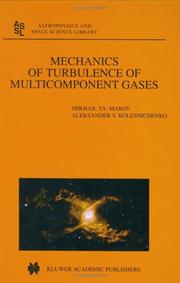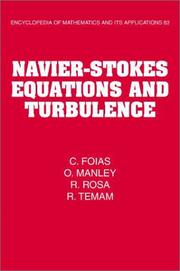| Listing 1 - 2 of 2 |
Sort by
|

ISBN: 0306480921 1402001037 Year: 2001 Publisher: Dordrecht : Springer Netherlands,
Abstract | Keywords | Export | Availability | Bookmark
 Loading...
Loading...Choose an application
- Reference Manager
- EndNote
- RefWorks (Direct export to RefWorks)
Space exploration and advanced astronomy have dramatically expanded our knowledge of outer space and made it possible to study the indepth mechanisms underlying various natural phenomena caused by complex interaction of physical-chemical and dynamical processes in the universe. Huge breakthroughs in astrophysics and the planetary s- ences have led to increasingly complicated models of such media as giant molecular clouds giving birth to stars, protoplanetary accretion disks associated with the solar system’s formation, planetary atmospheres and circumplanetary space. The creation of these models was promoted by the development of basic approaches in modern - chanics and physics paralleled by the great advancement in the computer sciences. As a result, numerous multidimensional non-stationary problems involving the analysis of evolutionary processes can be investigated using wide-range numerical experiments. Turbulence belongs to the most widespread and, at the same time, the most complicated natural phenomena, related to the origin and development of organized structures (- dies of different scale) at a definite flow regime of fluids in essentially non-linear - drodynamic systems. This is also one of the most complex and intriguing sections of the mechanics of fluids. The direct numerical modeling of turbulent flows encounters large mathematical difficulties, while the development of a general turbulence theory is hardly possible because of the complexity of interacting coherent structures. Three-dimensional non-steady motions arise in such a system under loss of la- nar flow stability defined by the critical value of the Reynolds number.
Planets --- Rarefied gas dynamics. --- Turbulence. --- Atmospheres. --- Flow, Turbulent --- Turbulent flow --- Fluid dynamics --- Superaerodynamics --- Fluid dynamics (Space environment) --- Gas dynamics --- Atmospheres of planets --- Planetary atmospheres

ISBN: 1107111544 1280416548 9786610416547 0511174381 0511039360 0511154224 051132829X 0511546750 0511052421 9780511039362 0521360323 9780521360326 9780511052422 9780511546754 6610416540 9780521064606 0521064600 9781107111547 9781280416545 9780511174384 9780511154225 9780511328299 Year: 2001 Volume: 83 Publisher: Cambridge New York Cambridge University Press
Abstract | Keywords | Export | Availability | Bookmark
 Loading...
Loading...Choose an application
- Reference Manager
- EndNote
- RefWorks (Direct export to RefWorks)
This book aims to bridge the gap between practising mathematicians and the practitioners of turbulence theory. It presents the mathematical theory of turbulence to engineers and physicists, and the physical theory of turbulence to mathematicians. The book is the result of many years of research by the authors to analyse turbulence using Sobolev spaces and functional analysis. In this way the authors have recovered parts of the conventional theory of turbulence, deriving rigorously from the Navier-Stokes equations what had been arrived at earlier by phenomenological arguments. The mathematical technicalities are kept to a minimum within the book, enabling the language to be at a level understood by a broad audience. Each chapter is accompanied by appendices giving full details of the mathematical proofs and subtleties. This unique presentation should ensure a volume of interest to mathematicians, engineers and physicists.
Turbulence. --- Navier-Stokes equations. --- Equations, Navier-Stokes --- Differential equations, Partial --- Fluid dynamics --- Viscous flow --- Flow, Turbulent --- Turbulent flow --- Turbulence --- Navier-Stokes equations
| Listing 1 - 2 of 2 |
Sort by
|

 Search
Search Feedback
Feedback About UniCat
About UniCat  Help
Help News
News